I’ll admit it—I’ve killed more than a few plants in my time. It’s not something I’m proud of, but as someone with limited gardening experience and an erratic schedule, keeping indoor plants alive can be quite a challenge.
If you’re anything like me, you might have found yourself wondering if there’s some sort of magical solution to keep your green friends happy and healthy without constant attention. Enter self-watering pots: these ingenious inventions promise to take care of your watering woes while giving your precious plants the hydration they need.
But are self-watering pots good for indoor plants? As much as we’d love a foolproof method for nurturing our indoor jungles, it’s important that we understand how these containers work and whether or not they truly improve plant health. After all, feeling safe knowing that our botanical buddies are thriving is what every plant parent dreams of!
So let’s dive into this wonderland of potentially worry-free watering and discover if self-watering pots are indeed the lifesavers we’ve been searching for.

Contents
- 1 Advantages Of Self-Watering Pots
- 2 Disadvantages Of Self-Watering Pots
- 3 How Do Self-Watering Pots Work?
- 4 Best Plants For Self-Watering Pots
- 5 Worst Plants For Self-Watering Pots
- 6 Self-Watering Pots FAQs
- 6.1 What soil do you use for self-watering pots?
- 6.2 How do you put soil in a self-watering container?
- 6.3 Do self-watering pots prevent root rot?
- 6.4 Do you put rocks in a self-watering planter?
- 6.5 How often do you put water in a self-watering planter?
- 6.6 How do you add fertilizer to self-watering pots?
- 6.7 Do self-watering pots have good drainage?
- 7 Conclusion
Advantages Of Self-Watering Pots
Convenience
Self-watering pots are an incredibly convenient way to take care of your plants. With just a few adjustments, you can set up the pot once and forget about it for weeks at a time.
This can be made possible thanks to their drainage system—which helps retain moisture while preventing over-saturation of water. You no longer have to worry about watering your plants on a daily basis. Instead, these useful systems allow for more efficient watering cycles that are only necessary once every few weeks.
All in all, these clever pots make taking care of indoor plants much simpler and hassle-free!
Saves Water
Imagine the satisfaction of contributing to water conservation while keeping your indoor plants happy and healthy. That’s exactly what you’ll get with self-watering pots!
These nifty containers allow for consistent moisture in the container soil, preventing over or under-watering and ensuring your precious plants aren’t parched.
You won’t need to worry about wasting water anymore— it’s a win-win situation for both you and our environment.
Retains Nutrients
Not only do self-watering pots save water, but they can also help keep your plants healthy!
The clever design prevents nutrient loss through water drainage and even allows for fertilizer to be added directly to the reservoir.
So not only are you keeping your plants safe from dehydration, but they’ll also have all the nourishment they need to thrive!
Now that’s what I call smart gardening.
Consistent Water Supply
One major advantage I’ve personally found with self-watering pots is the consistent water supply they provide to my plants. It’s such a relief knowing that there’s no need for me to constantly check if their soil is too dry or too wet—these smart containers simply take care of it all!
Plus, as someone who used to struggle with overwatering risks and maintaining optimal soil health, I can now confidently say that these pots have made a world of difference in my plant care routine. The built-in reservoirs ensure that water quality is maintained at just the right level, so my precious greens are always happily hydrated without any risk of drowning.
Trust me when I say that switching to self-watering pots has been a game-changer for both my indoor garden and overall peace of mind!

Disadvantages Of Self-Watering Pots
Mold And Mildew
I’ve got to be honest with you, one major downside of using self-watering pots is the risk of mold and mildew growth.
You see, these pots are designed for holding water which can create humidity in and around the plant’s environment.
Now, while managing water efficiently is a great thing for our plants, it also creates an ideal condition for fungal growth if we’re not careful.
To avoid this issue, it’s essential that we clean our pots regularly as a preventative measure against rot and other potential problems caused by fungi.
So remember, even though self-watering pots come with many perks, they do require some extra attention to keep your beloved indoor plants safe from harm.
Cost
Now, let’s talk about another aspect you might want to consider when deciding whether or not self-watering pots are the right choice for your indoor plants—cost.
It’s true that these handy planters can be a bit pricier than traditional pots, but I believe they’re worth it in the long run.
You see, their unique design helps conserve water by regulating watering frequency more efficiently than we humans often can.
So while you may initially shell out a little extra cash for a larger pot size or higher-quality materials, think of all the money and resources you’ll save over time due to less waste!
Just keep in mind that like any investment, it’s essential to weigh both pros and cons before making your final decision.
Not Suitable For All Plants
Now, let’s chat about another important factor to consider when deciding if self-watering pots are the right choice for your indoor plants—not all plants may thrive in them.
For example, some types of greenery need periods where their soil dries out completely between waterings—like cacti and succulents.
In these cases, using self-watering pots can lead to overwatering, which isn’t good news for our plant friends!
Additionally, certain plants require better soil drainage than what these clever containers provide.
So while it’s tempting to opt for convenience with self-watering pots, always remember that prioritizing the health and safety of our beloved botanical buddies is key!
How Do Self-Watering Pots Work?
So, you might be wondering how these self-watering pots actually work. Well, it’s quite simple and ingenious! The main components of a self-watering pot are the growing bed, water reservoir, and wicking system.
Now let me explain how these parts come together to keep your plants healthy:
- Growing bed: This is where your plant sits and grows.
- Water reservoir: A separate container that holds water, typically located at the bottom of the pot. Monitoring water levels in this reservoir is essential for ensuring there’s always enough water available for your plant. Water reservoir size varies depending on the type of pot or planter you choose; larger plants will need bigger reservoirs. Soil type selection also plays an important role in helping with proper watering as some soils absorb more moisture than others.
- Wicking System: This clever mechanism allows the roots of your plant to access just the right amount of water from the reservoir without overwatering them.
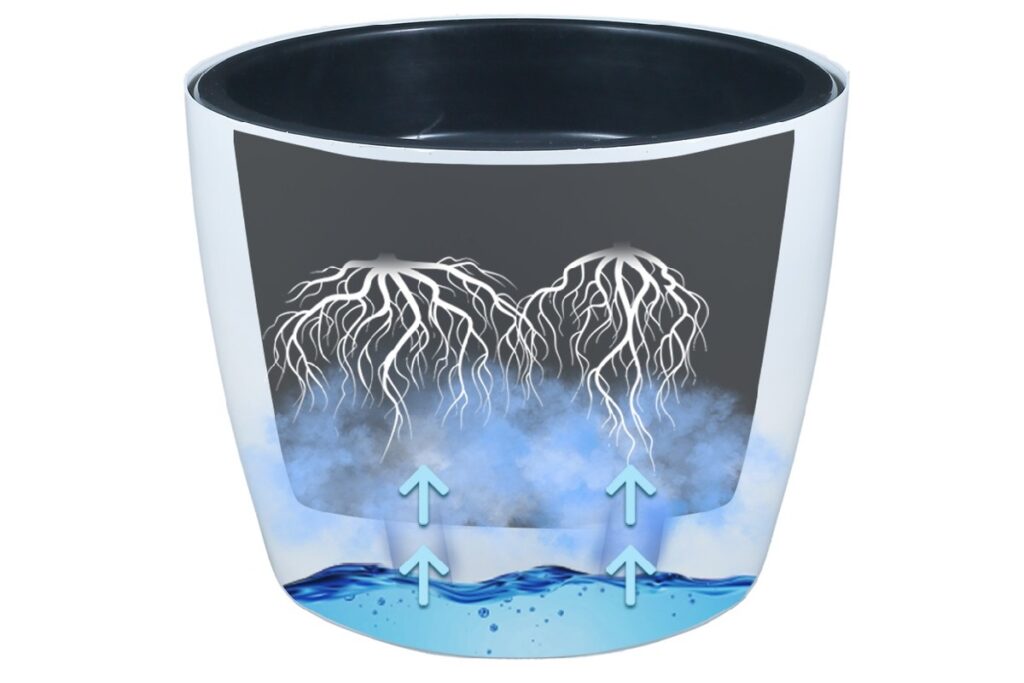
The main benefit of these pots is the ability to monitor water levels accurately and maintain consistent watering frequency without having to keep track manually. This makes it easier for people who may not have time to tend their indoor plants on a regular basis or don’t want to worry about over-watering them.
The different layers inside the pot also help prevent root rot by encouraging proper drainage and air circulation within the soil.
For busy individuals looking for convenient ways to make sure their plants stay alive and well indoors, self-watering pots are certainly worth considering!
Best Plants For Self-Watering Pots
Now that you know self-watering pots are a great way to take care of your indoor plants, let’s talk about what types of houseplants work best in these containers!
African Violets
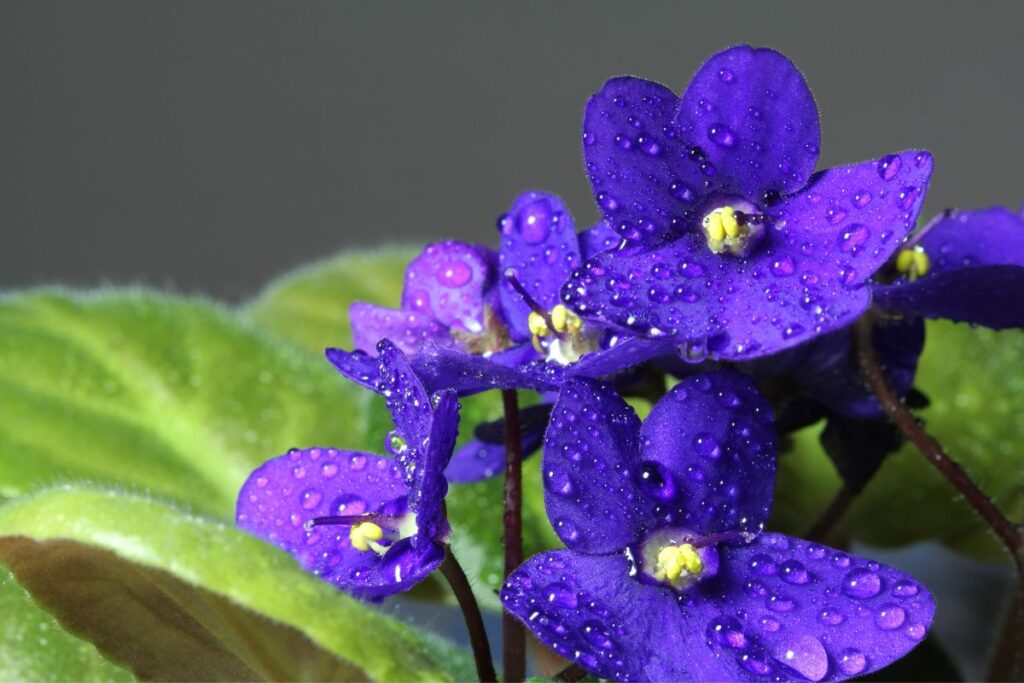
If you’re looking to add a pop of color to your indoor garden while ensuring the well-being of your precious plants, African Violets are an excellent choice for self-watering pots.
Their stunning purple blooms will brighten up any space, and with proper care in terms of lighting needs, soil types, and pot sizes, they’ll thrive beautifully!
Just remember that these delicate beauties don’t like soggy conditions—instead, they prefer consistent moisture without letting their roots sit in standing water.
So go ahead and give those charming African Violets a safe and nurturing home in a self-watering pot; trust me, both you and your plant will be delighted by the results!
Related Post:
7 Best Self-Watering Pots For African Violets
Pothos
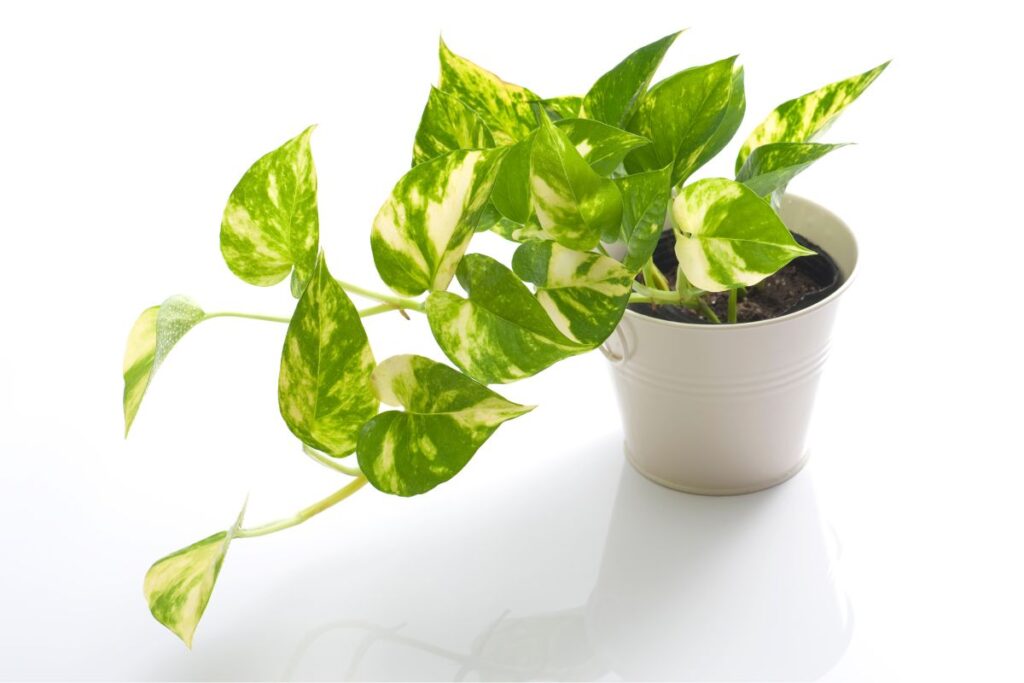
If you’re looking for a plant that’s hardy and easy to take care of, then the Pothos is your best bet.
Best suited for self-watering pots, it requires little watering frequency and will do well in any pot size as long as it receives enough light levels.
This low-maintenance houseplant can bring some much-needed color into your home with its attractive foliage that ranges from green to variegated white.
So why not try out this gorgeous addition to your home and give yourself one less thing to worry about?
Peace Lily
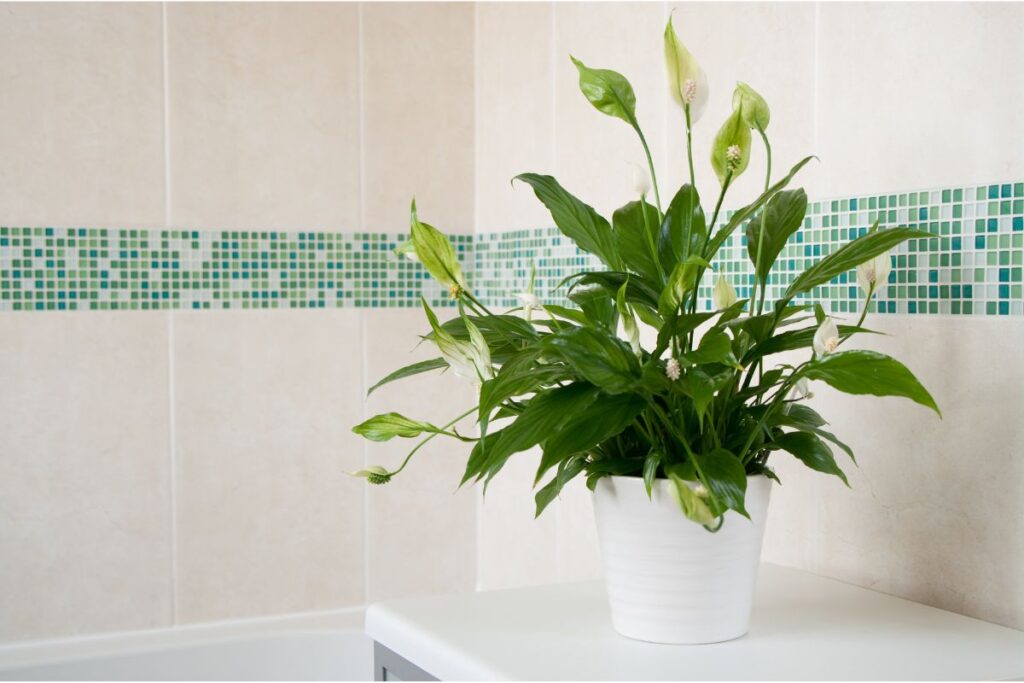
If you’re looking for a houseplant that won’t be a casualty of overwatering, then the peace lily is a great option for self-watering pots.
Not only does it require adequate drainage to avoid potential issues with root rot, but it also loves being in moist soil.
That makes this low-maintenance plant perfect for those who don’t have time to water often or struggle with remembering when they last watered their plants!
Plus, if your peace lily needs repotting due to becoming root bound, simply switch out pots and adjust your self-watering pot’s settings accordingly.
So if you want an easy-going indoor plant that doesn’t need too much fuss over watering—try out growing a peace lily today!
Monstera

Now that we’ve seen how the Peace Lily can thrive in a self-watering pot, let’s explore another fantastic plant choice: the Monstera.
As someone who cares about providing a safe and nurturing environment for our beloved plants, I can assure you that these pots work wonders for Monsteras too! By adjusting your watering frequency to suit their needs, these containers maintain consistent moisture levels without overdoing it.
The drainage system ensures there’s no standing water, so you don’t have to worry about root rot or other issues caused by excessive moisture. On top of this, managing fertilizer amounts becomes easier since excess nutrients won’t accumulate in stagnant water.
So go ahead and give your Monstera what it deserves—an opportunity to grow strong and healthy with a self-watering pot where safety is always paramount!
Worst Plants For Self-Watering Pots
Now that you know what types of indoor plants are best for self-watering pots, let’s talk about what types of houseplants won’t do well in these containers!
Succulents
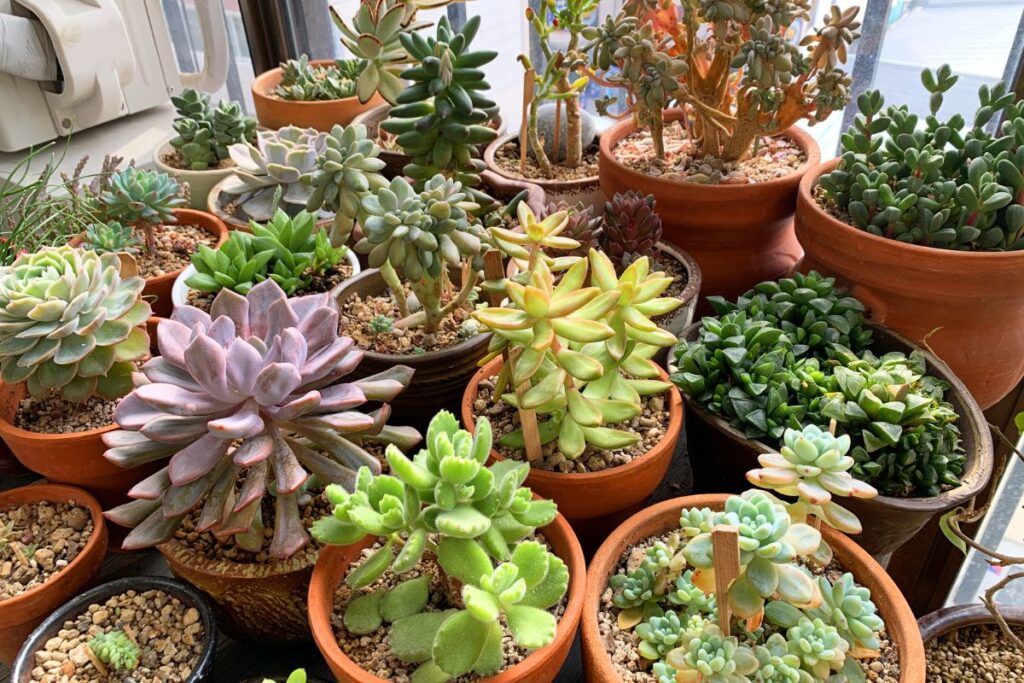
You might be tempted to use a self-watering pot for your precious succulents, but trust me, it’s not the best option.
Succulents like their soil dry and well-draining—just like in their native desert environment—so they’re not fans of constant moisture.
They need proper drainage holes to prevent water from sitting at the bottom of the pot because that can lead to root rot.
Remember, these plants are designed to retain water in their fleshy leaves, which means you don’t have to worry about watering frequency as much!
So while we all love convenience and safety when it comes to our indoor plants, let’s stick with traditional pots for our beloved succulents and allow them to thrive happily in the perfect soil type without overwatering them.
Cacti
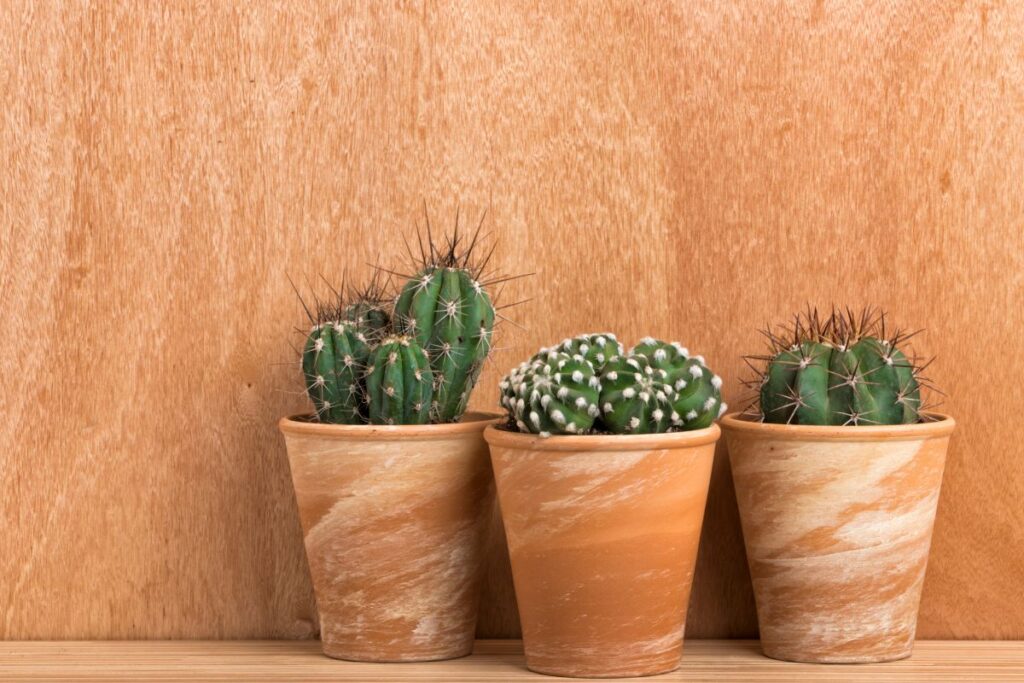
Moving onto cacti, they need to be watered even less than succulents do. The soil composition needs to be very dry and sandy while the watering frequency should only happen every few weeks or so.
Light requirements are also important when it comes to keeping your cactus alive; too much direct sunlight can burn its leaves! For this reason, self-watering pots aren’t ideal for cacti either since there’s no way of controlling how much water stays in the pot at all times.
Even though these plants require a little bit more effort when it comes to taking care of them, traditional pots are the way to go if you want your cactus healthy and thriving.
Self-Watering Pots FAQs
What soil do you use for self-watering pots?
For self-watering pots, it is essential to use a well-draining, moisture-retentive, and aerated soil mix to ensure proper water distribution and prevent root rot. A good choice for self-watering pots would be a mix of potting soil, peat moss or coco coir, perlite or vermiculite, and compost or well-aged manure. This combination provides the necessary nutrients, moisture retention, and drainage required for healthy plant growth.
Potting soil serves as the base of the mix and provides essential nutrients for the plants. Peat moss or coco coir helps retain moisture, ensuring that the soil stays damp but not soggy, as excessive moisture can lead to root rot. Perlite or vermiculite improves soil aeration and drainage, preventing waterlogged conditions in the self-watering pot. Compost or well-aged manure adds beneficial microorganisms and organic matter, enhancing the overall soil structure and fertility.
When preparing the soil mix, it’s essential to incorporate the components in the right proportions to achieve the ideal balance of moisture retention and drainage. A general guideline would be to use 50-60% potting soil, 20-30% peat moss or coco coir, 10-20% perlite or vermiculite, and 5-10% compost or well-aged manure. However, specific plant requirements may vary, so it’s essential to research the ideal soil conditions for the plants you intend to grow in your self-watering pots.
How do you put soil in a self-watering container?
To put soil in a self-watering container, begin by preparing the container and its various components. This will typically include the main container, an inner pot or liner with holes, a water reservoir, and a wick or capillary mat to draw water from the reservoir to the soil. Ensure that the container is clean and that all parts are functioning properly before proceeding.
Start by placing the wick or capillary mat inside the water reservoir, ensuring that one end of the wick is submerged in the water and the other end extends up into the inner pot or liner. This will allow water to be drawn up from the reservoir to the soil through the wick.
Next, add potting soil to the inner pot or liner. It is important to use a high-quality, well-draining potting mix that will allow the water to be absorbed and distributed evenly throughout the soil. Fill the inner pot or liner with soil, leaving enough space at the top for the plants and their root systems.
Before planting, thoroughly moisten the soil in the inner pot or liner. This will help to ensure that the wick or capillary mat is properly saturated and will also make it easier for the plants to establish themselves in their new environment. Once the soil is moist, you can proceed to plant your desired plants, taking care to follow proper planting techniques and spacing requirements for each specific plant.
Finally, fill the water reservoir with water, making sure not to overfill it. The water level should be below the bottom of the inner pot or liner to prevent the soil from becoming too wet. As the plants grow and consume water, the self-watering container will automatically draw more water from the reservoir to keep the soil consistently moist. Monitor the water level in the reservoir and refill it as needed to ensure your plants receive adequate water throughout their growth cycle.
Do self-watering pots prevent root rot?
Self-watering pots can help prevent root rot to some extent, but they are not a foolproof solution. Root rot typically occurs when plant roots are exposed to overly wet conditions for an extended period, leading to a lack of oxygen and the growth of harmful fungi or bacteria. Self-watering pots are designed to provide a consistent supply of moisture to plants by wicking water from a reservoir at the bottom of the pot into the soil. This system can help maintain an appropriate level of moisture and prevent the soil from becoming waterlogged, which is a common cause of root rot.
However, there are still factors that can lead to root rot even when using self-watering pots. One such factor is the type of soil used. A well-draining soil mix is essential for preventing root rot, as it allows excess water to drain away from the roots, preventing them from sitting in water for too long. If the soil does not drain well, even a self-watering pot may not prevent root rot. Additionally, overfilling the reservoir of a self-watering pot can lead to overly wet conditions and root rot. It is important to monitor the moisture level in the pot, ensuring it is not too wet, and to only fill the reservoir as needed.
Do you put rocks in a self-watering planter?
Yes, putting rocks in a self-watering planter can be beneficial for several reasons. Firstly, rocks can create a stable base for the soil, ensuring proper drainage and preventing the soil from becoming too saturated with water. This is particularly important in self-watering planters, as they are designed to provide a consistent supply of water to the plant. By adding a layer of rocks at the bottom of the planter, you can create a reservoir for excess water to collect, allowing the plant to draw up only the water it needs through a wicking system.
In addition to improving drainage, rocks can also help to aerate the soil, promoting healthy root growth and overall plant health. The gaps between the rocks allow air to circulate more freely through the soil, reducing the risk of root rot and other diseases that can thrive in poorly-aerated, waterlogged conditions. Furthermore, rocks can help to maintain a more consistent temperature in the soil, preventing fluctuations that could harm the plant. Overall, incorporating rocks into a self-watering planter can lead to more robust and healthy plant growth, and can be a valuable addition to your gardening toolkit.
How often do you put water in a self-watering planter?
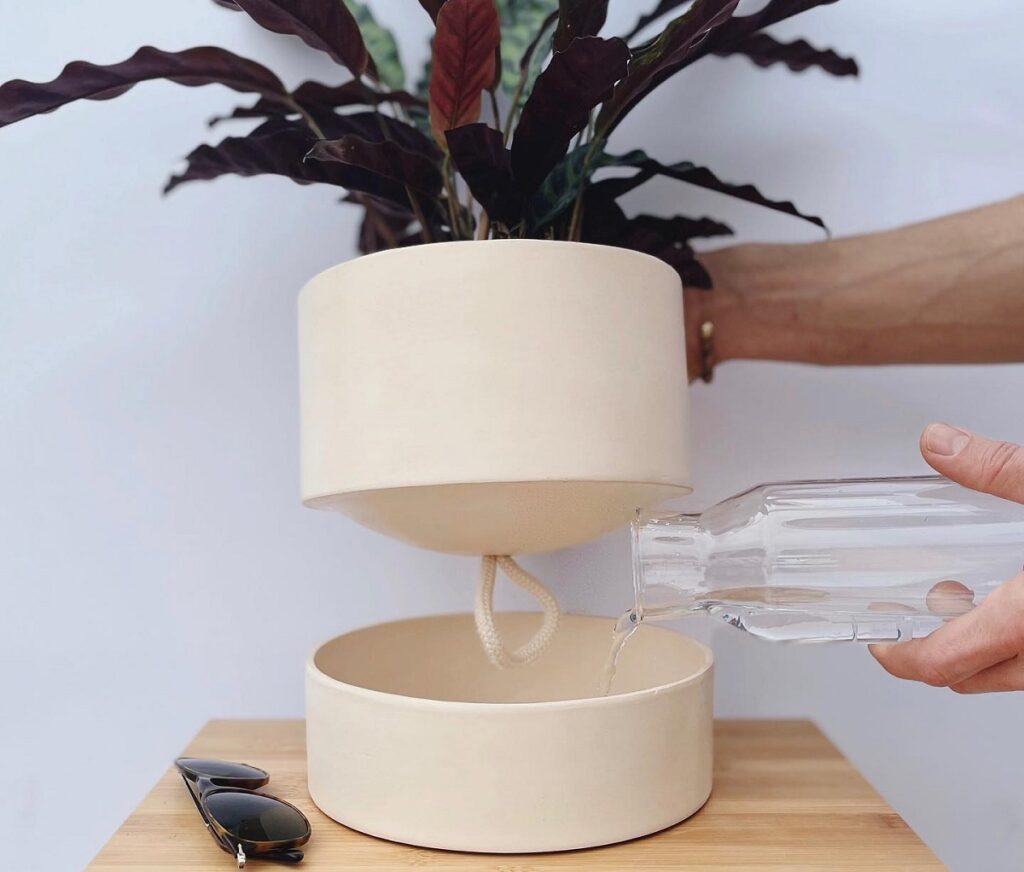
The frequency of adding water to a self-watering planter depends on several factors such as the size of the planter, the type of plant being grown, the environmental conditions, and the specific design of the self-watering system. Generally, you may need to refill the water reservoir every 1-4 weeks.
For instance, larger planters with a bigger water reservoir will require less frequent refilling as compared to smaller planters. Similarly, plants with higher water requirements, like vegetables and tropical plants, will consume water more quickly and may need a more frequent refill, while drought-tolerant plants or succulents may not require refilling as often.
Environmental factors such as temperature, humidity, and sunlight exposure can also impact the rate at which water is consumed by the plant. In hotter and drier conditions, plants may require more frequent watering as the water evaporates faster.
It is important to monitor the water level in the reservoir and adjust the refilling frequency according to the specific needs of your plant and the surrounding environment. Regularly checking the soil moisture and the health of the plant can also help in determining the appropriate watering schedule for your self-watering planter.
How do you add fertilizer to self-watering pots?
To add fertilizer to self-watering pots, you need to first choose the right type of fertilizer for your specific plants. It is recommended to use water-soluble or liquid fertilizers for self-watering pots, as they can be easily mixed with water and will be delivered to the plant roots through the self-watering system. Granular or slow-release fertilizers can also be used, but they might not be as effective in a self-watering pot as they rely on regular watering to break down and release nutrients.
To add the fertilizer, carefully read and follow the instructions on the fertilizer package for the correct dosage and dilution rates. Mix the fertilizer with water in a separate container, ensuring it is properly dissolved. Once the fertilizer solution is ready, pour it into the water reservoir of the self-watering pot. The self-watering system will then gradually deliver the nutrient-rich solution to the plant roots through capillary action or wicking.
Be sure to regularly monitor the water level in the reservoir and refill it with the fertilizer solution as needed. Also, keep an eye on your plant’s growth and health to determine if any adjustments need to be made to the fertilizer type, amount, or frequency. Regularly clean the water reservoir to avoid any build-up of salts or minerals that could harm your plants.
Do self-watering pots have good drainage?
Self-watering pots typically have good drainage systems built into their design. These pots contain a water reservoir at the bottom, which stores excess water that can be re-absorbed by the plant’s roots as needed. This reservoir is separated from the main planting area by a platform or wicking system, which allows water to be drawn up into the soil while preventing the plant from becoming waterlogged.
In addition to the water reservoir, self-watering pots often have overflow holes or channels to ensure that excess water can escape, preventing over-watering and root rot. This drainage system helps maintain the ideal moisture level in the soil, promoting healthy root growth and overall plant health. The combination of these features makes self-watering pots an excellent choice for gardeners looking for a low-maintenance and efficient way to care for their plants while ensuring proper drainage.
Conclusion
In conclusion, self-watering pots can be a fantastic addition to our indoor plant collection. They not only save us time and effort in maintaining proper watering schedules but also create a more consistent and healthier environment for our beloved plants to thrive. However, it’s important that we carefully consider the type of plant we’re growing before using these pots since some may not benefit from them.
From my personal experience, I’ve found that utilizing self-watering pots has saved me from the guilt of accidentally neglecting my plants during busy periods or while on vacation. It feels great knowing they have an uninterrupted supply of water even if I’m not around. Just remember to choose wisely when deciding which plants are most suitable for this system.
Ultimately, whether or not self-watering pots are good for your indoor plants depends entirely on individual circumstances and preferences. If you find yourself consistently struggling with overwatering or underwatering issues, then investing in these innovative containers might just be the perfect solution for you!
Happy planting!
